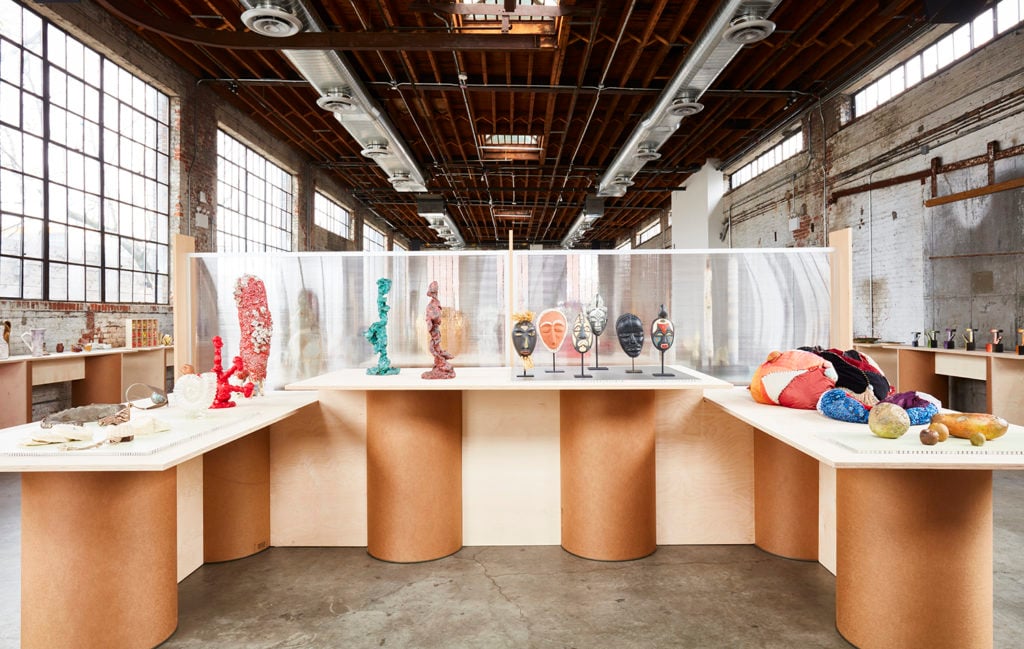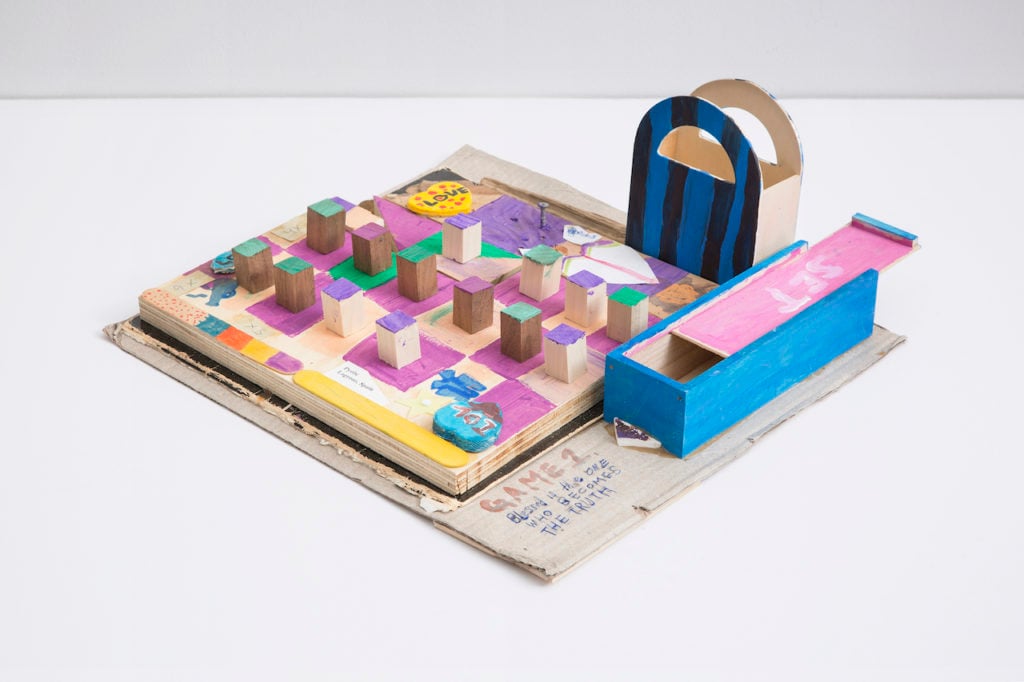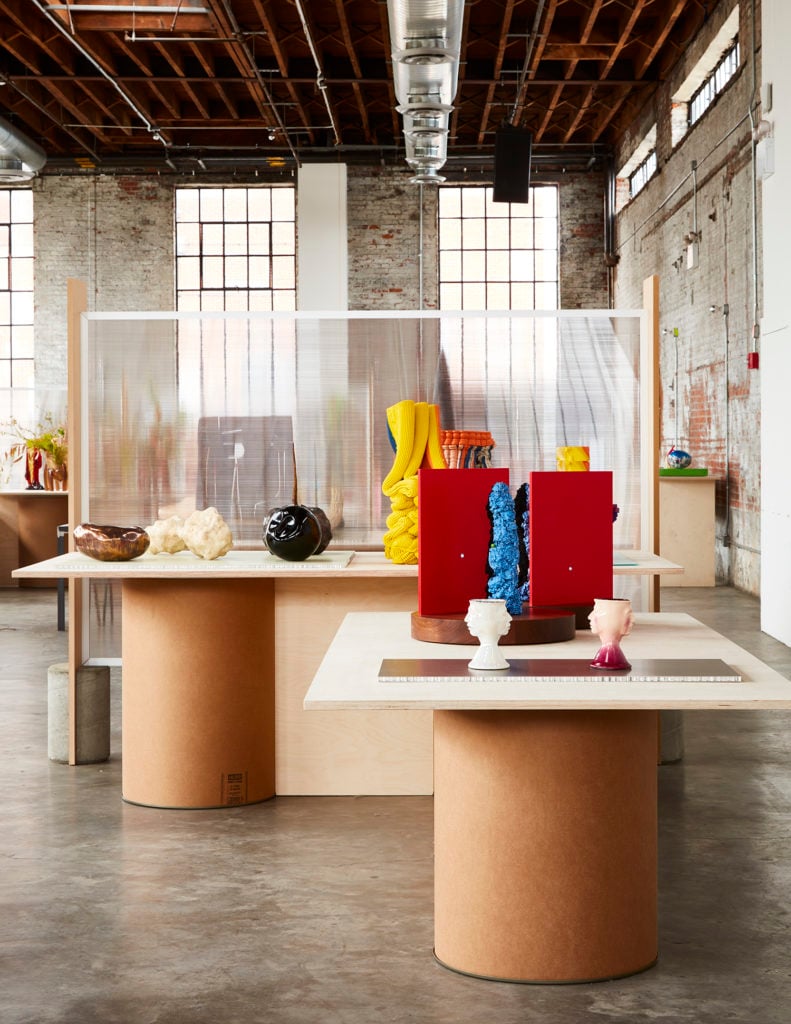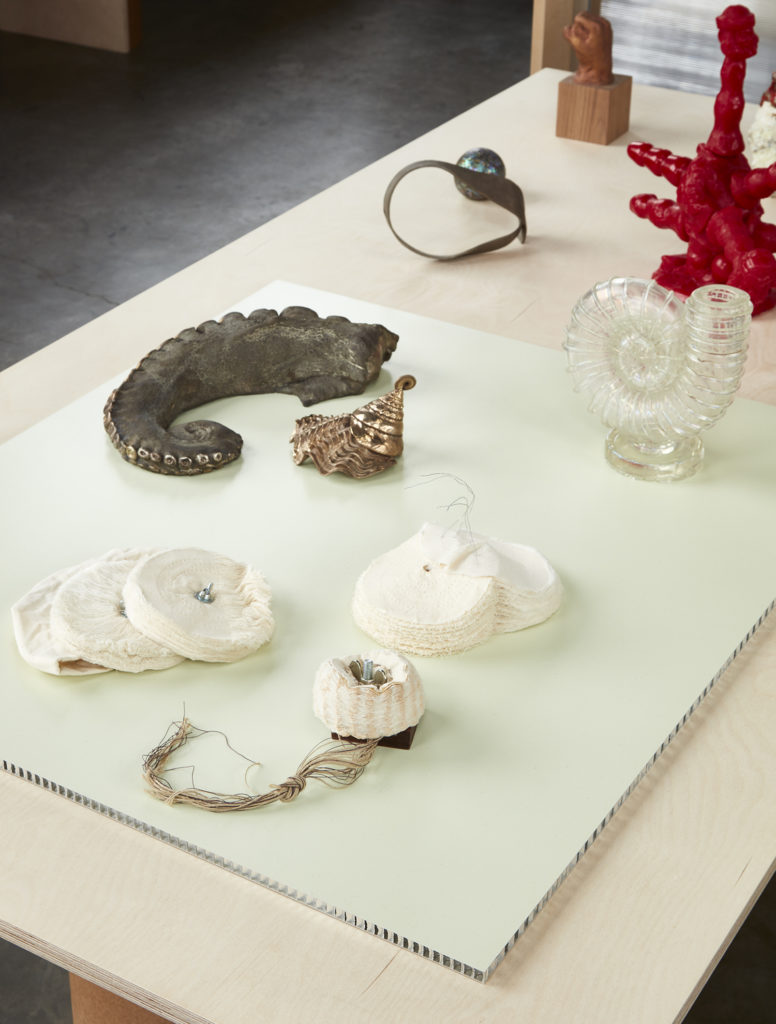Art Fairs
What Exactly Is Object & Thing? A New Fair With 4 Disruptive Ideas About How to Sell Art Today
Object & Thing upends the typical art-fair model by blowing up hierarchies, absorbing the exhibitors' risk—and much more.

Object & Thing upends the typical art-fair model by blowing up hierarchies, absorbing the exhibitors' risk—and much more.

Tim Schneider

Like so much else in the art world in 2019, whether you find Object & Thing a breath of fresh air or an affront to all that is good and pure in life largely depends on how seriously you take yourself. Billed as “a new art and design fair for objects,” the event opened to VIPs on Friday morning in Bushwick’s industrial-chic 99 Scott Avenue complex. And while opinions will vary, the features setting Object & Thing apart from the typical art fair have implications that reverberate well beyond the event’s admirably modest ambitions.
What are those features, and why should they matter to the art market at large? Let’s walk through them one by one.
Object & Thing isn’t just a fair without booths. It’s a true melting pot for its 32 exhibitors. Rafael de Cárdenas, the fair’s artistic director, curated different galleries’ items together without dividers of any kind into 15 “islands” placed throughout the main space. A single gallery exhibiting multiple artists or designers may have objects on multiple islands, and each island showcases objects from multiple exhibitors.
There are no visible labels identifying which of the roughly 200 objects on view are being sold by whom, either. Not even the physical map handed out at the fair attributes the works to specific galleries, though you can find out the answers if you go online. (More on this in a bit.)
In a phone interview before the fair’s opening, Abby Bangser, Object & Thing’s founder and creative director, told artnet News that this installation concept arose out of a desire to “erase the hierarchy between art and design,” as well as any “preconceived notion about the works” that would arise from separation of any kind.
The same principle applies to the hierarchy separating different tiers of the art market. Without encyclopedic knowledge of the artists on view, it’s impossible to know whether a small sculpture comes from, say, a globe-spanning mega-gallery like Hauser & Wirth (here showing works by Phyllida Barlow, Martin Creed, and Paul McCarthy, among others) or a respected, younger, single-location gallery like Bridget Donahue (here showing board-game works by Susan Cianciolo).
The Impact: Viewers evaluate the objects on their aesthetic merits first, not their genre or industry pedigree, evening the playing field in a way that defies the clearly coded layout of typical fairs.

Susan Cianciolo, Game I. Blessed is the ONE WHO BECOMES THE TRUTH, 2018. Photography by Gregory Carideo. Courtesy of Object & Thing.
Instead of charging a significant up-front booth fee, as most fairs do, Object & Thing collects a commission on sales made by exhibitors during the event. “Our revenue all depends on sales. We don’t know how we’ll do,” explains Bangser. “Having no booth fees puts us, the fair, in the position of risk, whereas typically galleries are the ones in that position.”
Bangser declined to provide the commission rate, saying only that it is “in line with” what galleries normally charge when they consign works to large commercial exhibitions. (As a reference point from my gallery career, this would generally be about 20 to 30 percent.)
The arrangement can affect more than just an exhibitor’s fiscal exposure. It can also influence their thinking about what to show. Bangser notes that smaller objects “often don’t have a commercial context” at typical art fairs because of their lower price points. Why bring quaintly scaled works when your primary concern is covering the costs you already fronted for the booth, let alone for shipping, installation, staffing, and other art-fair necessities?
By contrast, each of the objects on view in the main section of Object & Thing is priced between $1,000 and $50,000—a range that would be unsustainable for exhibitors at almost all other standard fairs in New York.
The Impact: By disrupting the typical art-fair payment structure, Object & Thing allows for atypical works at unexpected price points, broadening the event’s appeal to a wider, more middle-class audience.

Installation view of Object & Thing 2019. Photography by Pernille Louf. Courtesy of Object & Thing.
Another factor that sets Object & Thing apart from the art-fair norm is the absence of all exhibiting galleries’ employees. The only people on the sales floor are fair representatives, each armed with an iPad and placed strategically throughout 99 Scott’s interior to field inquiries from visitors about all of the objects in their immediate vicinity.
It’s nearly impossible to overrate the effect this swap has on the atmosphere. I won’t speak for the design world, but if you consider most art dealers to be approachable businesspeople, your baseline for negotiations must have been set in a maximum-security prison yard. The art market remains one of the only sectors where most sellers intentionally set out to make buying from them difficult, and this tends to remain true at art fairs unless your reputation as a collector (or very rich person) precedes you.
By replacing gallerists and their like-minded employees with a squad of unaffiliated staffers incentivized to actually be as helpful as possible, Object & Thing punctures the inflated aura of “collecting” and makes it feel much more like “shopping.”
If this sounds like an insult to you, please stop and think for a minute about how exactly you would explain to your mailman or a public schoolteacher what makes “collecting” something more rarefied than buying any other thing you’d like to own—and thus, something that should be governed by a set of artificially labyrinthine processes and discriminatory attitudes. (Remember, even Gagosian has a shop these days.)
Exhibitors benefit, too. Other fairs that charge a commission on sales instead of a booth fee carry a very real opportunity cost for exhibitors: the time spent working the salesfloor. For comparison, one participant in this year’s Spring/Break Art Show, which eschews booth fees for commission but asks exhibitors to be on site for all open hours, calculated that their roughly $15,000 in sales worked out to under $6 per hour per gallery partner for the run of the fair. By absolving galleries of the need to staff the fair themselves, Object & Thing removes yet another barrier to participation, especially in the context of showing lower-priced works.
The Impact: Transactions at Object & Thing become much lower stakes (and more appealing) than at a typical art fair, for buyers and sellers alike.

Installation view of Object & Thing 2019. Photography by Pernille Louf. Courtesy of Object & Thing.
Remember those iPads the Object & Thing staffers are toting? They’re all preset on the fair’s website, which boasts an easily searchable, illustrated inventory of every item on view. Potential buyers can browse the same site on their own devices, whether they’re physically at the fair or not, including filtering the works by artist, gallery, material, date range, and/or price range.
According to Bangser, the idea was to make collecting, not just looking, accessible to all. “Everything is very transparent,” she says. “The price is there, the dimensions, all that info exists [online].” The fair even commissioned former Museum of Arts and Design director Glenn Adamson, a member of its advisory committee, to write 50-word texts on each work—some of which are based on original research he conducted himself for this purpose—so that the site can be a bite-sized educational resource, too.
In fact, perusing Object & Thing online is dramatically more useful than using the physical handout at the fair, apart from the fact that only the latter has the “island” map. (This is an odd omission that I’d humbly suggest the fair reconsider for the next outing.)
This multi-channel experience more closely resembles what most of us now do when we’re inside a physical store, too. Who hasn’t navigated to a retailer’s website on their phone for more information about a product, like reviews or price comparisons, before deciding whether or not to actually take it to the register?
What’s more, buyers can also use the site to acquire anything that catches their eye—at least, starting Saturday at 10 a.m. Object & Thing incentivizes buyers to visit on the first day by giving actual attendees first crack at the available works, which can only be purchased through a fair representative until the physical doors open on the second day. Either way, all purchases can be made via credit card, a rare concession that once again makes the buying experience easier and more familiar to those outside the rare socioeconomic air of the “established collector.”
The Impact: By treating transparency and accessibility as pros, not cons, Object & Thing makes closing a deal easier for buyers and more likely for sellers—and explodes the tacit hierarchy that says only the lowest-priced works should be available online.
All of the above separate Object & Thing from the typical art fair, as well as the typical collecting experience in general. And if you think that sounds like sacrilege rather than salvation for the art market, consider the opinion of art advisor Benjamin Godsill, who had this to say about his visit to the fair during the VIP opening:
“I thought it was a magical space wherein the display systems highlighted the tactile and personable quality of most of the works. It’s a much more pleasant space for the visitors and the works, and the only fair where I’ve made a purchase for myself this week.”
Object & Thing is on view at 99 Scott Avenue through Sunday, May 5.